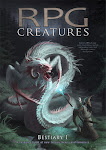For all those of of you who live above the Equator, enjoy the rest of summer! (even if it's the rainy season...) This time of year, you can swim comfortably, even in Sweden. Water is bliss!
≡GHORD≡

------GENERAL-----------------------------------------
CATEGORY: Invertebrate
TERRAIN: Tropical and subtropical oceans
FOOD: Carnivore
AGGRESSION: Normal
SIZE: 10 feet (3 m) long / Shell is 7 feet (210 cm) tall
NUMBERS: 1
------CHARACTERISTICS-----------------------------
STRENGTH: 15-18
AGILITY: 9-12
ENDURANCE: 13-16
INTELLIGENCE: 2-4
MENTAL RESILIENCE: 5-7
CHARM: 1-2
(If stats of a human ranges from 3 to 18)
SPEED: Walking (on the bottom) x 1, Swimming x 2
(Multiple is times human speed)
MAGIC POWER: 0
(Ranges from 0-100)
HIT POINTS: 19-24
(If a human commoner has about 11 hit points)
------PROTECTION-------------------------------------
AVERAGE: 5
BODY: 10 (0 without shell)
LIMBS: 0
HEAD: 1
(If Full Plate Armour is 10)
The body of the Ghord is soft and unprotected. The head and mouths have developed hardenend areas, which pose as horns and teeth. These are softer than regular skeletal structures, and have to be renewed regularly, as they break comparatively easily. The shells of the giant clams used by the Ghords are strong and thick, though not as hard as metal.
------ATTACKS/DAMAGE---------------------------
1 BITE: 2-5
6 LIMB-MOUTH BITES: 1-6 (+ possible stinging cells, see 'Powers')
(If a Long Sword causes 1-8 points of damage)
The protective shell, stinging cells, and size of the Ghord makes the vast majority of predators leave it alone, The Ghord is not used to fighting, nor fleeing. It will stay and do what it can to bite and ward off potential enemies, but will not pursue to kill.
------POWERS/EFFECT-------------------------------
STINGING CELLS: The red stinging cells growing on the Ghord's limbs and body is poisonous and will paralyse all beings (and most creatures) they come in contact with. These serve as a means of defence for the Ghord, which, though fairly intelligent, doesn't use them deliberately when attacking. However, any successful attack by a limb mouth may result in an involuntary (20% chance) and painful contact with the stinging cells. Areas protected by armour or clothes are not prone to the cells. The sting inflicts great pain and paralyzation, but causes no cellular damage. A normal sized being stay immobilized for 10-40 rounds. A succesful saving-throw vs Endurance may half that period. Holding the breath during paralyzation is impossible. Breathing is slow and frail.
REFLECTIVE CLOUD: The Ghord can eject a cloud of reflective ink. The substance looks a lot like water, but with a much greater reflective quality. Bursting out in a random shape, slightly larger than the Ghord itself, the cloud is confusing to behold, and will hide the Ghord's action for some time. Depending on the currents of the water, the clouds will last accordingly (2-5 rounds), but even drawn apart the drops and curtains of ink may confuse and blind the beholder. Unlike the octopus, Ghords rarely use the clouds to escape predators, but rather to attack them. Mouthed tentacle-like limbs will come shooting through the ink, targeted by the creatures' sensitive antenna, which grants them the ability to sense movement even when visually blinded. The Ghords may produce up to three clouds in a day.
------DESCRIPTION------------------------------------
The Ghords are large invertebrates, typically "walking" around slowly on the ocean floor. There they filter large amounts of water for plankton and other minute forms of life, sucking it all in through six great inlets. These mouths, at the edge of retractable tentacle limbs, may also trap a careless fish or two, and will happily consume any other moving thing in the water.
Though impressive creatures, Ghords protect themselves by seeking out the discarded shells of giant clams. These are pierced for extra holes and made into custom fit armours. All limbs may be drawn back into the shell at great speed, and can re-appear with equal velocity. When moving around the Ghords are not as swift. They can swim, even inside the shell, but do so in a rocking fashion, paddling themselves forward with two shovel-like limbs, and pushing for altitude with their big sluggish “foot”.
It may be the innate mode of survival, to look out for suiting shells of protection, that is behind the Ghords' habit of hoarding. The creatures are unusually interested in all things uncommon to the natural forms of the sea. Especially hollow items, like canoes, coffins, and amphorae attract their attention. They are even more interested in glimmering ones, reminiscent of the surface of clams and mother of pearl. Coins and trinkets may be found discarded on the floors of the caves in which the Ghords keep their collections, which suggests a specific interest in the vessels themselves.
As the hoard grows the Ghord becomes increasingly reluctant to leave its cave of treasures, and will try to find what food it needs in the immediate surrounding of the entrance. In rich waters, the creatures may well be posted, like a sentry, just outside the cave, refusing to leave its valuable collection. Most Ghords will fiercely protect every part of their findings, but some specimens are reported to have engaged in trade. It seems a few of these creatures are intelligent enough to evaluate the threat level, the offers, and the desires of visitors, to the extent that they present one item in return for another. Persistence, repeated sign-language, and a great sense of balance are said to have done the trick in these reported cases.
Ghords are solitary creatures, which live for 60-70 years. They mate early, while only 5-10 years of age. They then redraw from reproduction, and spend their time standing, or walking slowly, in search for food and other items of interest. They change shells 3-5 times during the span of their lives.
(Check out more creatures in the 'Creature Archive' menu to the left.)
© Copyright 2011 - Nicholas Cloister







